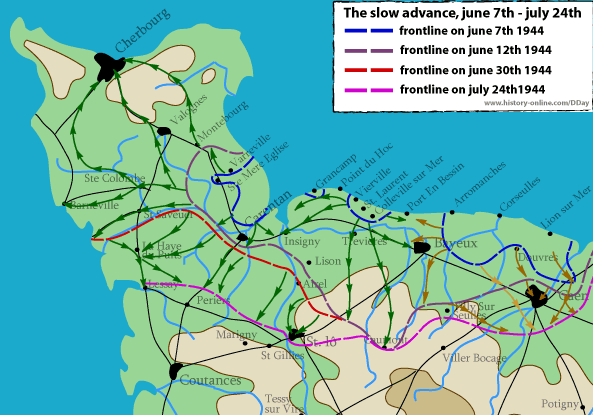Cherbourg and Caen
Many objectives had still to be reached on the eve of D-Day + 1, June 7, 1944.
The American sectors were not very deep, OMAHA was still vulnerable and two days were required before establishing a connection with the British coming from GOLD. UTAH was isolated from other zones (the linking up with OMAHA would take place June 10) and the forces assigned to this sector had the very important objective of Cherbourg and its port.
The large British and Canadian sector represented the situation of major success and prepared to take by siege Caen.
From the German point of view the two principal risks were the losses of Cherbourg and Caen. Cherbourg is situated at the point of a peninsula and could be easily reached by the Allies who appropriately landed at its base, while Caen, 230 km from Paris, was still firmly in German hands and all the roads were open to allow the flow of reinforcements from the north and the south of France.
Exactly for these reasons Rommel singled out this sector as the most dangerous one and on which to concentrate all the field forces and the mobile reserves, including the armored forces, which the Fuhrer jealously maintained under his complete control.
This map shows the lines of approximate advancement of the American forces (green), British (brown) and the Canadians (light orange). The lines of the front are also approximate, fruit of the mediation between numerous resources.

The Battle for Caen
On June 10 an imposing German attack was launched, in which the 4th Armored Division, the 2nd, 12th SS, 21st and Panzer Lehr. The Allies fought with two British armored divisions and about 5 infantry divisions, with which they absorbed and repelled the dangerous shock to then launch a counterattack. To the east some terrain was gained but not important progress was made toward Caen. Montgomery organized several operations, “Epsom,” “Charnwood” and “Goodwood,” with the scope of breaking through the defenses of the city, an enterprise that succeeded at the end of July.
The British mission had begun the mission with relative success, if confronted with the American missions, but then it lost the advantage conquering only a few kilometers in nearly two months of bitter fighting. That can be attributed in large part to the choice made by the Germans to concentrate the effort on Caen, but also to some of the choices made by Montgomery, considered by many too prudent and hardly incisive. Considering the vicinity of the beaches, from which reinforcements and supplies reached, and the forces used by the Allies, 3 British corps and one Canadian corps, for the Germans the loss of key objectives like Caen was mitigated by having been able to block the Allies for so long.
The Rush toward Cherbourg
The task of the VII Corps US, commanded by general Collins, was to capture Cherbourg and the entire Cotentin Peninsula.
The corps made some progress in the first days after D-Day, advancing north and following the main road that links Carentan to Cherbourg, but it was slowed down at the gates of Montebourg. In all of the region the fighting took place between the rows of trees, which largely favored who was on the defense, in this case the German forces. The Allied victims were much greater than those had during D-Day and those calculated for this period.
With grave losses and with an impetus–valorous for some, cynical for others–General Collins managed to push beyond his own forces. The 82nd and 101st Airborne Divisions had the task of isolating the Cotentin Peninsula and reaching the western coast of the peninsula at Barneville on June 18. Together with the 4th Infantry Division they had to protect the southern flank of the corps. The 17th Panzer Grenadier Division (mechanized infantry) and other two divisions of German infantry put pressure on this front.
The German forces defending Cherbourg and the fortified positions in the outskirts of the city put up a strong resistance, but June 27, after many days of fighting, the German garrison surrendered to the Allies to the total disappointment of Hitler, who would have demanded a defense to the bitter end, up until annihilation.
For the Allies, however, it was not a matter of victory. The port was mostly destroyed, the port’s infrastructures had been sabotaged, there were mines everywhere and only after a few months of work by the engineers the port would be reactivated. Many lives were paid for an objective perhaps not even realistic.
Following the fall of Cherbourg the American forces in the Cotentin Peninsula moved south, acting in conjunction with the corps arrived from OMAHA and moving the front south by several dozens of kilometers.